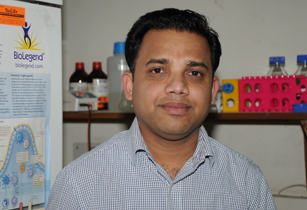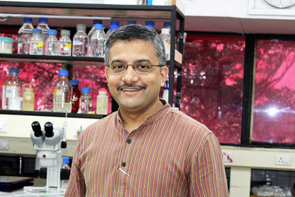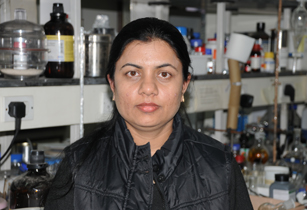Dr. Debasisa Mohanty
Bioinformatics & Computational Biophysics; Prediction of structure and function of proteins; In silico analysis of genomes; Computer simulation of biomolecular systems
The main theme of the research project is to understand the structural principles that govern sequence to structure relationships in proteins and binding of various ligands to proteins. These structural principles are being used to develop novel knowledge based computational methods for prediction of substrate specificity of proteins and also for predicting structural folds for proteins in absence of detectable sequence homology. Such computational tools can assign specific functions to various putative proteins in genomes and hence help in identification of novel metabolic pathways and protein interaction networks in newly sequenced genomes.
Substrate specificity of biosynthetic proteins & identification of novel metabolic pathways
Prediction of substrate specificity of proteins has been a difficult task due to the lack of suitable scoring functions for accurate evaluation of protein-ligand interactions. Recent work from our laboratory has demonstrated that reliable prediction of substrate specificity can be carried out by combining evolutionary information from large number of proteins of known substrates, with structural information on active site geometry from homologous crystal structures. This work has provided a computational framework for correlating chemical structures of the polyketide or nonribosomal peptide products to the sequences of their respective megasynthases consisting of a variety of catalytic domains. Collaborative experimental work has demonstrated that these computational methods are not only useful in identification of biosynthetic products of uncharacterized proteins in newly sequenced genomes, they can also be used for rational design of novel natural products.
We are currently extending such predictions of structural fold and substrate specificity to other enzyme families with the objective of developing powerful computational methods for correlating sequence of other classes of biosynthetic proteins to their metabolic products, not only in prokaryotes but also in eukaryotes. Similar computational approach is also being used to analyze enzymes associated with novel post translational modifications like AMPylation, Eliminylation etc.
Prediction of protein-peptide interaction & identification of protein interaction networks
Our research group is also investigating whether knowledge based structural bioinformatics approaches can be used for identifying protein interaction networks mediated by peptide recognition modules (PRMs) like kinases, SH3, SH2, WW, PDZ etc. Even though, a number of computational methods have been developed for identifying interaction partners of various PRMs, most of these studies have used a sequence based approach and have identified interaction partners based on motifs/profiles obtained from sequence analysis of a known set of experimentally identified interaction partners. Thus the applicability of such training based methods is limited to only those families of PRMs for which experimental substrate data is available. Therefore it is necessary to develop structure based approaches, which do not require training using experimental substrate data. We have developed a knowledge based computational protocol for modeling structures of protein-peptide complexes and used this protocol to formulate a novel structure based approach for predicting substrates of protein kinases and MHC proteins. The success of our structure based approach for protein kinases and MHCs encouraged us to develop similar structure based multi-scale approaches for deciphering substrate specificities of other PRMs like PDZ, WW, SH2, SH3 etc.
Systems biology approach for identification of conserved network modules & deciphering their dynamic features
Apart from the approach of predicting metabolic and signaling networks based on substrate specificity or function of the component proteins, we also plan to use the systems biology approach of deciphering novel metabolic, signaling and transcriptional networks based on identification of conserved network motifs/modules and understanding their dynamic features.
Bhushan Dilip Dhamale, Sana Amir, Akshay Khanduja, Ankita Pal, Sapna Pal, Sureshkumar V(RCB-NII), Shweta Mahapatra, Vikas Kumar, Dr. Sanjeet Kumar Mahtha, Apratim Kumar Pandey, Sumeet Kumar Yadav.
Awards:
• National Bioscience Career Development Award (2009)
• Fellow of Indian National Science Academy (Elected in 2013)
• Fellow of Indian Academy of Science (Elected in 2012)
• Fellow of The National Academy of Sciences, India, Allahabad (Elected in 2008)
• Rajib Goyal Young Scientist Prize in Life Sciences (2007)
• Samanta Chandrashekhar Award (2005) by Orissa Bigyan Academy (DST, Govt. of Orissa)
- Khanduja, A., M. Kumar, and D. Mohanty. 2023. ProsmORF-pred: a machine learning-based method for the identification of small ORFs in prokaryotic genomes. Briefings in Bioinformatics doi: 10.1093/bib/bbad101.
- Mehdiratta K, Nain S, Sharma M, Singh S, Srivastava S, Dhamale BD, Mohanty D, Kamat SS, Natarajan VT, Sharma R and Gokhale RS* (2023) Respiratory Quinone Switches from Menaquinone to Polyketide Quinone during the Development Cycle in Streptomyces sp. Strain MNU77. Microbiol Spectr 11:e0259722. doi: 10.1128/spectrum.02597-22.
- Gupta P, Venkadesan S and Mohanty D* (2022) Pf-Phospho: a machine learning-based phosphorylation sites prediction tool for Plasmodium proteins. Briefings in Bioinformatics 23: bbac249. doi: 10.1093/bib/bbac249.
- Gupta P and Mohanty D* (2022) Allosteric regulation of the inactive to active state conformational transition in CDPK1 protein of Plasmodium falciparum Int J Biol Macromol 215:489-500. doi: 10.1016/j.ijbiomac.2022.06.065
- Mehdiratta K, Singh S, Sharma S, Bhosale RS, Choudhury R, Masal DP, Manocha A, Dhamale BD, Khan N, Vivekanand A, Sharma P, Ikeh M, Brown AC, Parish T, Ojha AK, Michael JS, Faruq M, Medigeshi GR, Mohanty D, Reddy DS, Natarajan VT, Kamat SS* and Gokhale RS* (2021) Kupyaphores are zinc homeostatic metallophores required for colonization of Mycobacterium tuberculosis, Proc Natl Acad Sci U S A 119:e2110293119. doi: 10.1073/pnas.2110293119.
- Kumar P and Mohanty D* (2021) Development of a novel pharmacophore model guided by ensemble of waters and small molecule fragments bound to SARS-CoV-2 Main protease. Molecular Informatics e2100178. doi: 10.1002/minf.202100178.
- Gupta P and Mohanty D* (2021) SMMPPI: A machine learning based approach for prediction of modulators of protein-protein interactions & its application for identification of novel inhibitors for RBD:hACE2 interactions in SARS-CoV-2. Briefings in Bioinformatics bbab111. DOI: 10.1093/bib/bbab111.
- #Agrawal P, #Amir S, Deepak, Barua D and Mohanty D* (2021) RiPPMiner-Genome: A Web Resource for Automated Prediction of Crosslinked Chemical Structures of RiPPs by Genome Mining. J Mol Biol 433(11):166887. (#Equal contribution)
- Agrawal P and Mohanty D* (2020) A machine-learning based method for prediction of macrocyclization patterns of polyketides and nonribosomal peptides. Bioinformatics 37:603-611.
- Kaur P, Rausch M, Malakar B, Watson U, Damle N, Chawla Y, Srinivasan S, Sharma K, Schneider T, Jhingan G, Saini D, Mohanty D, Grein F and Nandicoori V (2019) LipidII interaction with specific residues of Mycobacterium tuberculosis PknB extracytoplasmic domain governs its optimal activation Nat. Comm. 10(1):1231.
- Kaur H, Sain N, Mohanty D and Salunke DM (2018) Deciphering evolution of immune recognition in antibodies. BMC Struct Biol 18(1):19.
- Agrawal P, Khater S, Gupta M, Sain N and Mohanty D* (2017) RiPPMiner: A bioinformatics resource for deciphering chemical structures of RiPPs based on prediction of cleavage and cross-links. Nucleic Acids Res 45 (W1): W80-W88.
- Khater S, Gupta M, Agrawal P, Sain N, Prava J, Gupta P, Grover M, Kumar N and Mohanty D* (2017) SBSPKSv2: structure-based sequence analysis of polyketide synthases and non-ribosomal peptide synthetases. Nucleic Acids Res 45 (W1): W72-W79.
- Sharma C and Mohanty D* (2017) Molecular dynamics simulations for deciphering structural basis of recognition of pre-let-7 miRNAs by LIN28. Biochemistry 56:723-735.
- Sain N and Mohanty D* (2016) modPDZpep: a web resource for structure based analysis of human PDZ-mediated interaction networks. Biol Direct 11:48.
- Sain N, Tiwari G and Mohanty D* (2016) Understanding the molecular basis of substrate binding specificity of PTB domains. Sci Rep. 6: 31418.
- Khater S and Mohanty D* (2015) Deciphering the Molecular Basis of Functional Divergence in AMPylating Enzymes by Molecular Dynamics Simulations and Structure Guided Phylogeny. Biochemistry 54:5209-24.
- Khater S and Mohanty D* (2015) In silico identification of AMPylating enzymes and study of their divergent evolution. Sci Rep. 5:10804.
- Khater S and Mohanty D* (2015) novPTMenzy: a database for enzymes involved in novel post-translational modifications. Database (Oxford). 2015: bav039.
- Khater S and Mohanty D* (2014) Genome-Wide Search for Eliminylating Domains Reveals Novel Function for BLES03-Like Proteins. Genome Biol Evol. 6:2017-33.
- Damle NP and Mohanty D* (2014) Mechanism of Autophosphorylation of Mycobacterial PknB Explored by Molecular Dynamics Simulations. Biochemistry 53:4715-26.
- Tiwari G and Mohanty D* (2014) Structure Based Multi-Scale Approach for Identification of Interaction Partners of PDZ Domains. J. Chem. Inf. Model. 54:1143-56.
- Damle NP and Mohanty D* (2014) Deciphering kinase-substrate relationships by analysis of domain specific phosphorylation network. Bioinformatics 30:1730-8. DOI:
- Tiwari G and Mohanty D* (2013) An In Silico analysis of the binding modes and binding affinities of small molecule modulators of PDZ-Peptide interactions. PLoS ONE 8(8):e71340.
- Anand S and Mohanty D* (2012) Inter domain movements in polyketide synthases: A molecular dynamics study. Molecular Biosystems 8, 1157-1171.
- Anand S, Prasad MVR, Yadav G, Kumar N, Shehara J, Ansari MZ and Mohanty D* (2010) SBSPKS: structure based sequence analysis of polyketide synthases. Nucleic Acids Res. 38:W487-96.
- Kumar N and Mohanty D* (2010) Identification of substrates for Ser/Thr kinases using residue based statistical pair potentials. Bioinformatics 26:189-97.
- Yadav G, Gokhale RS and Mohanty D* (2009) Towards Prediction of Metabolic Products of Polyketide Synthases: An In Silico Analysis. PLoS Comput Biol 5(4): e1000351.
- Kumar N and Mohanty D* (2007) MODPROPEP: A program for knowledge based modeling of protein-peptide complexes. Nucleic Acids Res 35: W549-55.



























